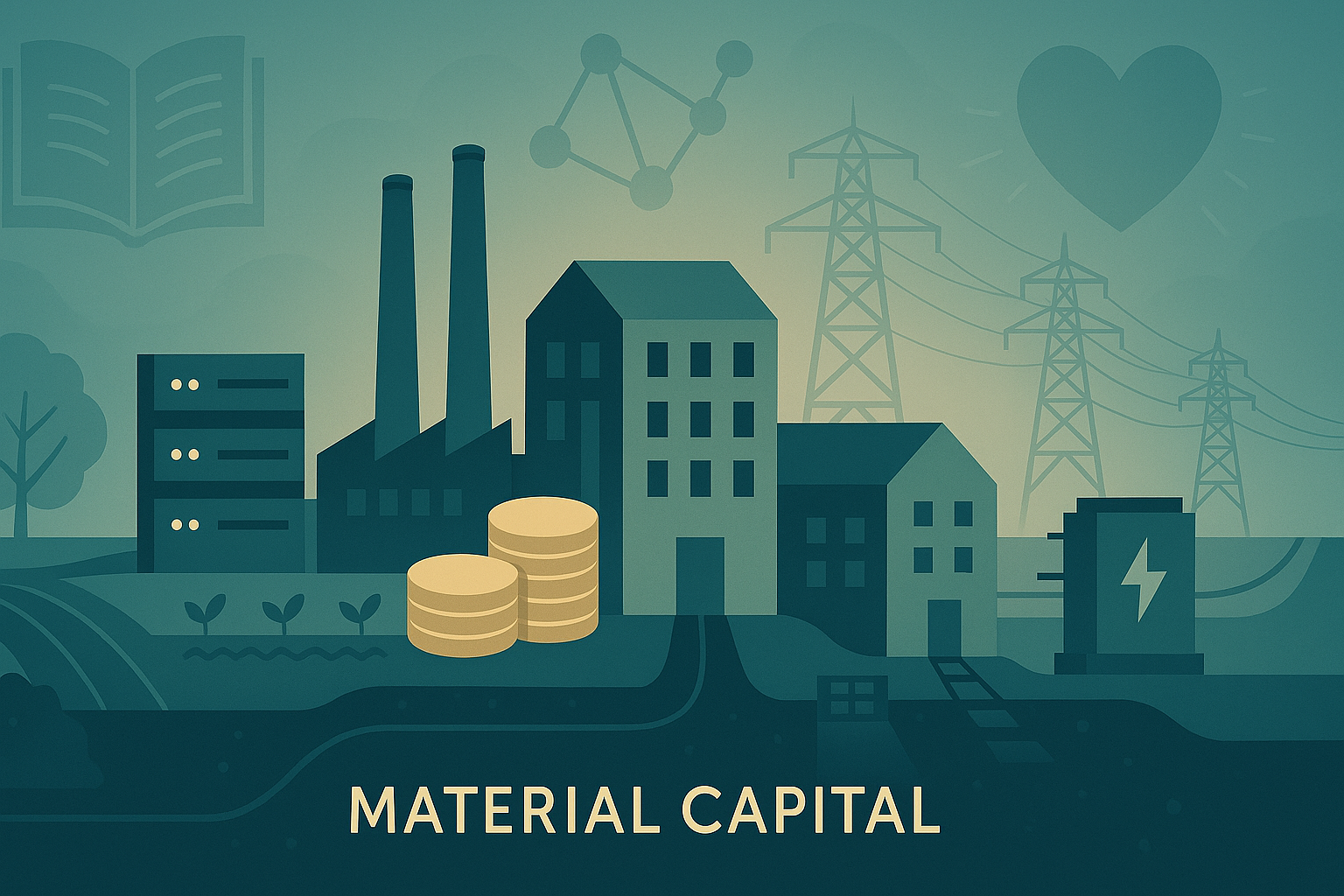Chapter 3: Material Capital
 Material (or economic) capital
refers to tangible assets that can be valued in money and used
to produce goods and services. It includes funds, equipment,
buildings, land, inventories, infrastructure, and natural
resources. In classic economics this was the primary meaning of
“capital,” and it remains a foundation for prosperity today.
Material (or economic) capital
refers to tangible assets that can be valued in money and used
to produce goods and services. It includes funds, equipment,
buildings, land, inventories, infrastructure, and natural
resources. In classic economics this was the primary meaning of
“capital,” and it remains a foundation for prosperity today.
What material capital
includes
• Financial assets:
cash, accounts, investments available for productive use.
• Physical assets: machinery, tools, vehicles, buildings, and
facilities.
• Infrastructure:
transportation, energy, water, and communication networks.
• Natural assets: land, minerals, forests, water, and other
natural stocks.
Today’s note:
in modern economies, energy systems, digital connectivity, and
even computing capacity function as core parts of material
capital because they enable nearly all other activity.
How material capital works
Material capital expands capacity, reduces constraints, and
provides resilience. It supports production, distribution, and
protection. When thoughtfully maintained and renewed, it creates
a stable base for growth in the other capitals. When neglected,
it deteriorates (depreciation), creates bottlenecks, and raises
costs for everyone.
What material capital is
not
It is not the whole
story of development. Money and machines alone cannot deliver
innovation, coordination, or legitimacy. Without intellectual
capital (knowledge), social capital (trust and cooperation), and
spiritual capital (values and purpose), material assets are
underused or misused.
Principles for building and
using material capital
•
Fit for purpose: invest in the right assets for the mission, not
just bigger ones.
•
Maintenance matters: sustaining what exists often yields more
than constant expansion.
•
Resilience by design: diversify critical inputs (energy,
suppliers, logistics).
•
Externalities count: consider environmental limits and long-term
community well-being.
•
Complements over silos: align material assets with knowledge,
relationships, and values.
Everyday examples (brief)
• A clinic installs reliable power and safe storage (material),
enabling consistent care and fewer errors.
• A family bakery upgrades ovens and delivery vehicles
(material) after standardizing recipes (intellectual), improving
both output and quality.
•
A city invests in water systems and broadband (material), which
multiplies the benefits of schools and businesses already in
place.
Common confusions
(clarified)
• Wealth vs.
income: material capital is a stock (what you have), whereas
income is a flow (what you earn).
• Cost vs. value: the purchase price of an asset differs from
the value it generates over time.
• Ownership vs. access: sometimes access (leasing, sharing) is
more effective than owning everything outright.
• Private assets vs. public goods: many essential assets—roads,
grids, clean air—are shared and require collective stewardship.
Modern extensions
Material capital now spans both physical and digital
infrastructure. Efficient logistics, reliable energy, safe
buildings, and robust data centers are all part of the base that
lets societies function. Environmental and resource constraints
matter: sustainable use of land, water, and energy protects the
very capital on which future production depends.
Interaction with the other
capitals
Material ×
Intellectual: equipment and infrastructure produce more when
paired with skills, data, and good process.
Material × Social: trusted supplier and community networks
reduce downtime and supply risk.
Material × Spiritual: clear purpose and ethical standards guide
investment toward long-term, constructive uses.
Conclusion
Material capital remains
essential to human well-being and economic performance. It
provides the physical means and financial resources to make
ideas real and communities safe. Yet material assets achieve
their best results when balanced with intellectual, social, and
spiritual capitals—an approach at the heart of 4Capital theory.